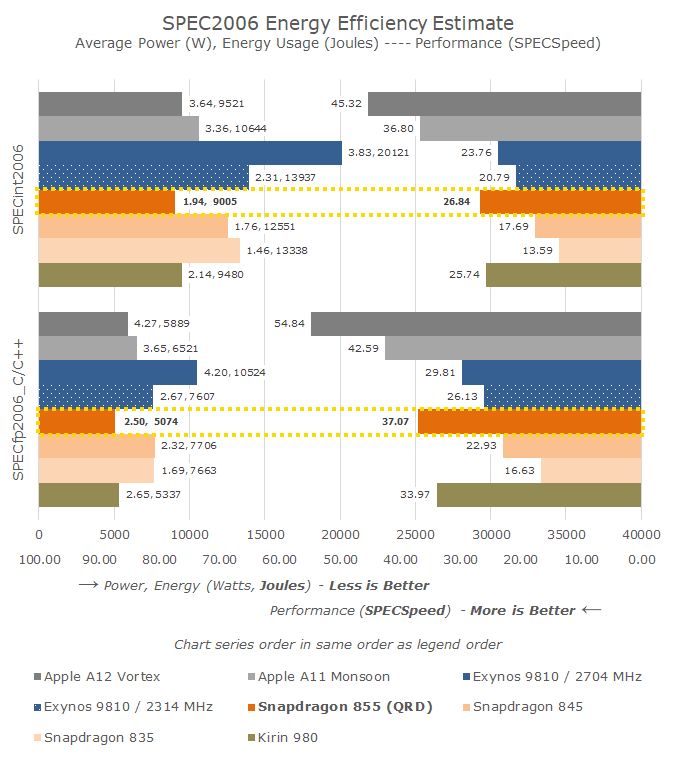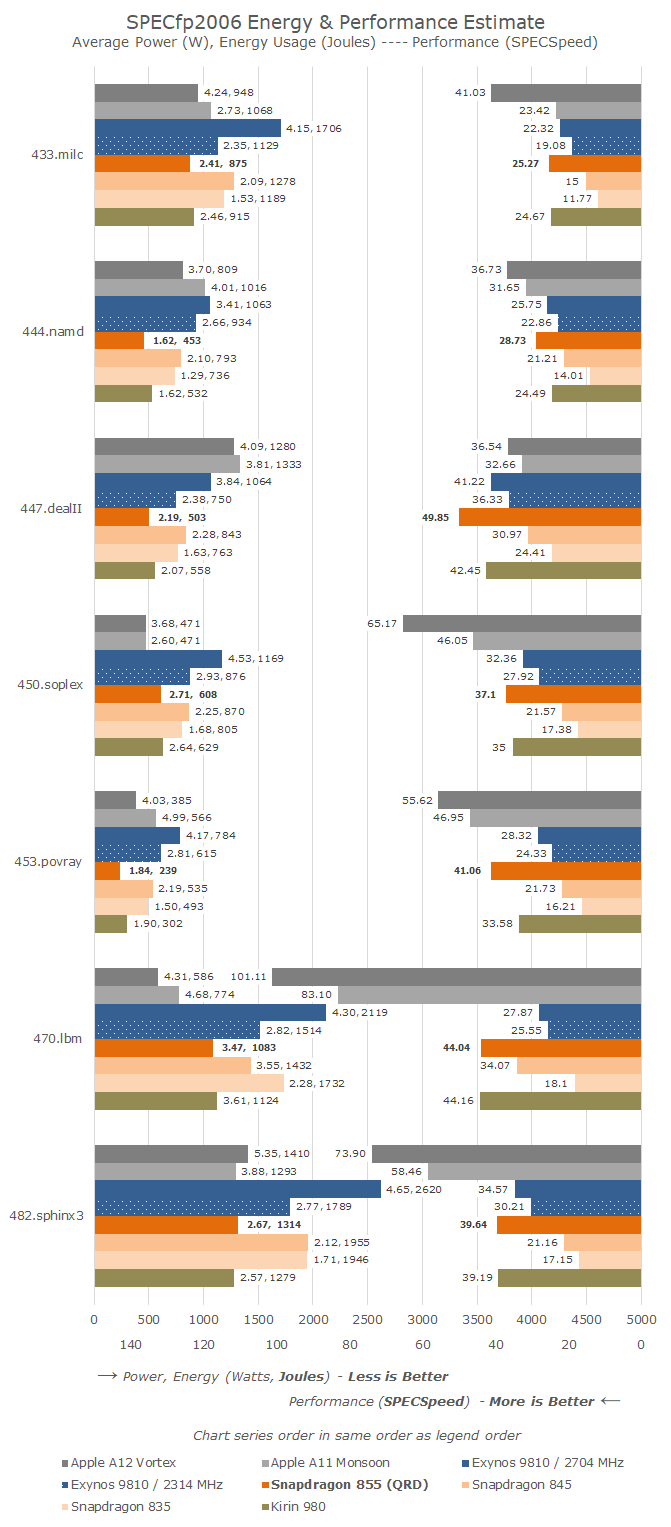The Snapdragon 855 Performance Preview: Setting the Stage for Flagship Android 2019
by Andrei Frumusanu on January 15, 2019 8:00 AM EST- Posted in
- Mobile
- Qualcomm
- Smartphones
- SoCs
- 7nm
- Snapdragon 855
CPU Performance & Efficiency: SPEC2006
We move on with our analysis by using SPEC2006 on the Snapdragon 855 QRD. SPEC2006 is an important benchmark as not only does it represent a tool that is used by many companies to architect their CPU designs, but it also a very well understood and academically documented workloads that can serve as a macro-benchmark to determine microarchitectural aspects of a CPU and system.
It’s to be noted that SPEC2006 has been deprecated in favour of SPEC2017, and although we’ll switch to that at some point, for mobile platforms SPEC2006 still represents a good benchmark. Because our scores aren’t official submissions, as per SPEC guidelines we have to declare them as internal estimates from our part.
A Big Note on Power on the QRD
Although for this article I was able to collect power figures for both CPU and GPU workloads, the figures are not of an as high certitude as when measured on commercial devices. The reason for this is that much like last year’s Snapdragon 845 QRD, this year’s 855 platform reports rather high idle power in the 950-1050mW range, about 500mW more than one would expect in a final product. Because our power measurement methodology represents publishing active system power, meaning we measure total power during a given workload and subtract the idle power under the same conditions, there is a degree of uncertainty if the idle power by default is quite high.
Today’s power efficiency figures thus merely represent a guideline – and we’ll make sure to re-test the results once we get our hands on final commercial devices.
The Results – The Snapdragon 855 Performs Admirably
We’ll start off with the aggregate results and drill down in the detailed results later:
The Snapdragon 855 ends up performing extremely well, ending up neck-and-neck with the Kirin 980’s performance, which shouldn’t come as too big of a surprise.
In SPECint2006, the Snapdragon 855 performs 51% better than the Snapdragon 845, all while improving power efficiency by 39% over its predecessor. Against the Kirin 980 which is currently its nearest Android competitor, the Snapdragon just slightly edges ahead by 4%.
In SPECfp2006, the Snapdragon 855 shows an even bigger 61% leap over the Snapdragon 845, and also manages to better showcase the 9% clock speed advantage over the Kirin 980, sporting a similar performance lead.
Again what is most important in these results is the power efficiency figures. One of the things that had me worried during Qualcomm’s Snapdragon 855 launch in Hawaii last month is that the company pretty much avoided talking or publishing any meaningful power efficiency claims on the side of the CPU. Fortunately it seems there wasn’t any need to be concerned as the Snapdragon 855, at first glance, seems to be extremely efficient even on the high clocked 2.85GHz Prime core.
Detailed Results
Drilling down into the detailed results, the one comparison that is most interesting is the performance of the Snapdragon 855 against the Kirin 980. On one hand the Snapdragon 855 is clocked 9% higher as well as promises some tuned microarchitectural characteristics which promise to improve IPC – while on the other hand HiSilicon’s implementation is more straightforward and brings with itself a bigger L3 cache as well as memory latency advantages.
In the vast majority of workloads, both chipsets are neck-and-neck, only diverging in some key aspects. In less memory hierarchy demanding workloads, the Snapdragon more easily is able to showcase its clock speed advantage. In more latency sensitive workloads, this difference shrinks or reverses. 462.libquantum is an interesting result as Qualcomm commented that its lead here is primarily due to the customisations made on the CPU core – although they wouldn’t exactly specify which aspect in particular is bringing the boost.
The biggest performance discrepancy on the negative side of things is the 13% disadvantage in 458.sjeng – the benchmark is most sensitive to branch mispredictions and again here Qualcomm has stated they’ve made changes to the branch data structures of the core.
What is most odd for me to see as a result, is the fact that 429.mcf performs admirably well on the Snapdragon 855 – which goes against intuition given the platform’s memory latency disadvantage. It is possible here that the Snapdragon 855 performs better than the Kirin 980 due to its better L3 cache latency?
On the SPECfp2006 results, the results can be very clearly categorised into two sets: In one set the Snapdragon 855 clearly showcases a healthy advantage over the Kirin 980, up to very notable 17% and 22% leads in 447.dealII and 453.povray. In the other set, the Snapdragon is again neck-and-neck with the Kirin 980, and these happen to again be the workloads that are most memory sensitive in the FP suite.
Overall, the Snapdragon 855’s CPU performance does not disappoint. Performance on average is ahead of the Kirin 980, although not by much. Here both chipsets are most of the time neck-and-neck, and it will mostly depend on the workload which of the two will take the lead.
More important than performance, the efficiency of the Snapdragon 855 is top-notch, exceeding what I had expected from the higher clock implementation of the chip. There is still a degree of uncertainty over the power numbers on the QRD platform, but if these figures are representative of commercial devices, then 2019’s flagship will see excellent battery life.














132 Comments
View All Comments
austonia - Tuesday, January 15, 2019 - link
Wow that was really impressive, said no one. Apple is like 2 to 3 years ahead and QC isn't gaining any ground. 5G is a big nothingburger. If my Note4 ever burns out I'mma get a fruit-phone next time. Unrivaled performance, better security, LTS for the OS, etc. Rather have an equivalent Pixel but Google isn't even trying from the look of it.eastcoast_pete - Tuesday, January 15, 2019 - link
@Andrei: Thanks, always appreciate the level of detail in your reviews. Question: QC's concept of 1xbigFast + 3 bigNotsofast + 4 little cores might be especially suited to execute, for example, JavaScript during web browsing, as JS is single-threaded. Did you observe that to be the case?eastcoast_pete - Tuesday, January 15, 2019 - link
To be more specific: I am also a bit underwhelmed by 855's performance in the web-browsing benchmarks. How much weight does JavaScript performance have in those benchmarks. If JS performance is a significant component of the web benchmarks, the single fast Big core layout would indeed be a bit of a dud.0iron - Tuesday, January 15, 2019 - link
Trivia: How many "here" in this article especially at the beginning of sentences? :)Hung - Wednesday, January 16, 2019 - link
What were the 845 benchmarks run with? Because the Pixel 3/XL has its A75 core clocked at 2.5GHz, while the Galaxy S9's is clocked at 2.7GHz and the LG G7's A75 runs at the stock 2.8GHz. Not a huge difference admittedly, but it definitely skews results slightly if you're comparing the maximum clock for the 855 versus the lower clocked version of the 845.Andrei Frumusanu - Wednesday, January 16, 2019 - link
Wrong, I don't know where you got the idea they're clocked differently. They're all 2.8.coit - Wednesday, January 16, 2019 - link
To me the trouble is being stuck with Google.Jredubr - Wednesday, January 16, 2019 - link
Another year that we'll see Apple's SOCs slaughtering Android's SOCs in raw performance.While I'm glad for the efficiency gains, that's far from enough if Qualcomm wants to remain competitive.
Failing to meet the performance of a SOC that Apple released 1 year and a half ago and sometimes even failing meeting A10 performance just isn't enough for a 7nm SOC.
sean8102 - Wednesday, January 16, 2019 - link
I'm guessing part of it is due to how much of a monopoly they are. When it comes to Android it dominates the market. A few like Samsung, Huawei etc make their own SOC's but that's about it. MediaTek is the only other I can think off but it's rare at least in the US to see them in anything but mid to low range phones and even then its still usually Qualcomn you'll get in that market range.From what I've read/seen one of the things that makes Apple's SOC's so fast is the large amount of cache they use. A12 having 8 MB of L3 cache, the 855 has 2 MB. Having so much cache is quite expensive and makes the die size larger which of course increases costs as well. Maybe Qualcomn just isn't getting much demand from OEM's to build such a expensive chip. If they made it and no OEM wanted to pay the price for it they would be stuck holding the bag.
Raqia - Wednesday, January 16, 2019 - link
Apple doesn't have an integrated modem so it has been choosing to use that extra space for beefy, 7-wide, die space hungry CPUs and caches. Although they bench well and have world leading efficiency, those CPUs draw too much current for the small batteries that come with an iPhone and lead to the controversial and unannounced throttling they decided to enact through iOS updates to preserve battery longevity. An on die modem also saves consumers money in the end from lower packaging cost and simpler PCB layouts.